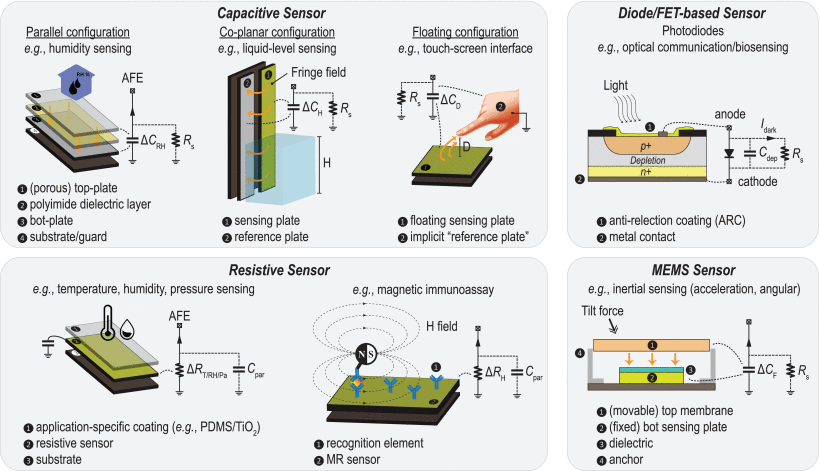Current Sensing Front-Ends: A Review and Design Guidance
The fundamental principle of a sensor is to transduce a physical stimulus into a measurable quantity, like an electrical signal. The sensors with current as electrical signal output are referred to as current-output or simply current sensors. These current sensors respond to a wide variety of changes, ranging from environmental parameters like temperature, pressure, or light to biomolecular parameters. However, a sensor is not a standalone device. A complete sensing system requires an efficient front-end interface design, connecting the sensors to processors.
Researchers present a comprehensive analysis of current sensors, their application specific specialty and deficiencies. It also provides a comparative study of design and performance tradeoffs of different analog front-end (AFE) circuit interfaces.
Based on the principle of transduction, current sensors are categorized as capacitive, resistive, diode/FET-based, and micro-electro-mechanical system (MEMS) sensors. Typically, capacitive and resistive sensors are biased at a constant voltage. Sensor material changes impedance in response to external stimuli, generating a measurable current signal. The working principle behind diode- and FET-based sensors is the reduction of semiconductor barriers in response to stimuli. Photodiodes and ion-sensitive field-effect transistors (ISFETs) sensors are examples of semiconductor sensors. MEMS sensors are considered one of the breakthrough technologies, integrating Electrical and Electronic sensors, actuators, and mechanical devices into a single chip. MEMS sensors consist of mechanical structures designed with microelectronic wafers and work by measuring differential capacitance.
Sensors have become indispensable in almost every industry, whether for measuring liquid levels, monitoring the environment, controlling touch interfaces, analyzing materials, or life science. Touch interfaces mostly use capacitive and resistive sensors, whereas semiconductor sensors are useful as electrochemical biosensors, DNA hybridization, and immunoassays.
An analog front-end (AFE) circuit amplifies and noise-filters the electrical signal before digitizing it through an analog-to-digital converter (ADC). The current-sensing architectures discussed here include current-to-voltage converters or transimpedance amplifiers (TIA), current-to-frequency converters (I to F), and current mode circuits.
A current-to-voltage amplifier uses a transimpedance element like a resistor. TIAs have simple circuits and a reasonable trade-off between design parameters such as noise, bandwidth, and power. TIA circuits are suitable for low-noise sensor applications but not for ultra-low-noise applications.
Current conveyors (CC) handle all signals in the current domain without needing a transimpedance element, excluding them from the need for a high-performance closed-loop amplifier. But it is usually challenging to design low-noise CCs over a large bandwidth. Current-mode delta-sigma (I-ΔΣ) modulators, consisting of a loop filter, a quantizer, and a feedback network, have been gaining interest as sensor interfaces for direct current-to-digital conversion.
I to F converters convert the sensor current into a pulse waveform having frequency directly proportional to the current. The sensor has significantly reduced area, power consumption and circuit complexity. These low area requirements of this converter make it suitable for small implantable or wearable devices.
The newly developed ultra-sensitive sensors require better performing AFEs. Researchers continuously strive to improve AFEs through innovative circuit designs.




